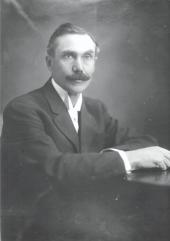
Walter Scott was born on a farm near Ilderton, Ontario, on October 27, 1867. In 1885, he moved west to Portage La Prairie and worked as a journalist with C.J. Atkinson, owner and editor of the Manitoba Liberal. In 1886, Scott followed Atkinson to Regina where he worked for the Regina Journal before buying half of the Regina Standard and all of the Moose Jaw Times. In 1895, he bought the Regina Leader from Nicholas Flood Davin. Scott supplemented his income with land speculation in and around Regina. Scott married Jessie Read and they adopted Dorothy, Jessie’s niece. They had no children of their own.
Scott was first elected to the Canadian House of Commons in 1900 for the constituency of Assiniboia West, defeating the incumbent Nicholas Flood Davin. Scott represented his constituency in the North-West Territories as a backbencher in the Wilfrid Laurier government and was re-elected in the general election of 1904. Scott and the Minister of the Interior, Clifford Sifton, influenced the development of the autonomy bills which created the two new provinces of Alberta and Saskatchewan. Three controversial issues arose: one province or two; should the provinces have control of mineral rights; and should there be separate schools. Two provinces were created; the two provinces did not gain the right to control their own mineral rights until twenty-five years later; and separate schools were allowed but within one public school system. On September 4, 1905, Saskatchewan became a province.
Lieutenant-Governor Amédée Forget chose Walter Scott as the first Premier. The first general election was on December 13, 1905. Under the campaign slogan “Peace, Progress and Prosperity,” the Scott government won a majority. Scott and his government were re-elected in 1908 and 1912. As Premier, Minister of Public Works and, later, Minister of Education for eleven years in total, Scott led his government in building a public administration and infrastructure for the new province. He supervised the construction of the legislative building in Regina and opened the University of Saskatchewan in Saskatoon. Agriculture was the cornerstone of the new government, and the University of Saskatchewan became the first university in Canada to have a College of Agriculture alongside the other professional colleges.
From 1905 to 1916, the Scott government used the co-operative model to assist farm families to build and maintain a rural telephone system and the Saskatchewan Co-operative Elevator Company. The government provided financial backing, but the farmers were required to invest some of their own money in the co-operative and thus had a voice in its operation. The Scott government set a bold social policy by banning the bar and establishing government-controlled liquor stores. This was a step toward full prohibition, which came under the leadership of Scott’s successor, William Martin. In 1916, the Scott government passed legislation to provide the franchise to women.
Throughout his premiership, Scott suffered from manic depression and was absent from his office up to six months of each year. With extra effort during his days of good health and with loyal support from James Calder, his Deputy Premier, Scott was able to lead an active and progressive government. By 1916, two problem areas began to weigh heavily on Scott. Reverend Murdock MacKinnon, a Presbyterian minister in Regina, launched a public campaign against the Scott government for its legislative amendments to the School Act, which, according to MacKinnon, encouraged the Catholics to establish their own school system. At the same time, the Scott government was accused of graft in the letting of contracts for public projects. Several members of the Scott government were accused of accepting bribes in a vote concerning the distribution of liquor licenses. Full investigations cleared Scott and his Cabinet of any wrongdoing, but the charges and the battle with MacKinnon were enough to force Scott to resign in ill health on October 20, 1916.
The Scotts retired to Victoria, but his health never recovered to the point that he was able to return to his career in journalism. In 1935, Scott was committed to the Homewood Sanitarium in Guelph, Ontario, where he died on March 23, 1938.
Walter Scott’s legacy was assisting in the creation of Saskatchewan by building its public administration and civil service, fostering a public infrastructure with a legislative building and a provincial university, and promoting an agricultural industry and a rural way of life for thousands of new settlers. To assist the farming population, under a co-operative model, the Scott government led the way in the establishment of an elevator system and rural telephone companies. Scott was a man of the people and won all five elections he contested with ever larger majorities. His social policies of closing the bars and granting the vote to women were progressive for the time. Under Scott’s leadership, the provincial Liberal Party became a strong force that stayed in office continuously from 1905 to 1944, with one exception from 1929 to 1934.
Gordon L. Barnhart